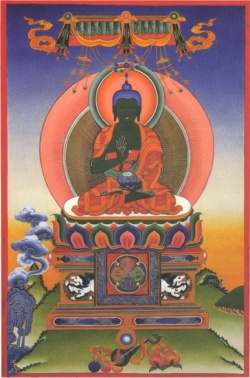Difference between revisions of "Amoghasiddhi Mantra"
m (Text replacement - "mysterious" to "mysterious") |
|||
| (One intermediate revision by one other user not shown) | |||
| Line 1: | Line 1: | ||
[[File:Amoghasiddhi2.jpg|thumb|250px|]] | [[File:Amoghasiddhi2.jpg|thumb|250px|]] | ||
[[File:Amoghasiddhima.png|thumb|250px|a mo gha si ddhi]] | [[File:Amoghasiddhima.png|thumb|250px|a mo gha si ddhi]] | ||
| − | [[Amoghasiddhi]] occupies the northern quarter of the [[mandala]]. He is depicted as a [[Bhikṣu]], and is deep green in colour. His name means infallible (amogha) success ([[siddhi]]). [[Amoghasiddhi]] is the head of the [[karma]] family in the Five [[Buddha]] [[Mandala]]. | + | [[Amoghasiddhi]] occupies the northern quarter of the [[mandala]]. He is depicted as a [[Bhikṣu]], and is deep green in {{Wiki|colour}}. His [[name]] means infallible ([[amogha]]) [[success]] ([[siddhi]]). [[Amoghasiddhi]] is the head of the [[karma]] family in the Five [[Buddha]] [[Mandala]]. |
| − | Amoghasiddhi's emblem is the double [[vajra]] - a mysterious [[symbol]] which is two five pointed [[vajras]] arranged in a cross. His [[mudra]] is [[Abhaya]] or [[Fearlessness]]. [[Abhaya]] can also mean "no [[danger]]". Amoghasiddhis is associated with the [[Tantric]] [[Rite]] of [[Fearlessness]], and with success or [[siddhi]]. | + | [[Amoghasiddhi's]] emblem is the double [[vajra]] - a mysterious [[symbol]] which is two five pointed [[vajras]] arranged in a cross. His [[mudra]] is [[Abhaya]] or [[Fearlessness]]. [[Abhaya]] can also mean "no [[danger]]". Amoghasiddhis is associated with the [[Tantric]] [[Rite]] of [[Fearlessness]], and with [[success]] or [[siddhi]]. |
| − | Like his counterpart [[Ratnasambhava]] he first appears in the Sarvatathāgata [[Tattvasaṃgraha]] [[Tantra]] in the late 7th or early 8th century. His name means "unfailing [[accomplishment]]". | + | Like his counterpart [[Ratnasambhava]] he first appears in the [[Sarvatathāgata]] [[Tattvasaṃgraha]] [[Tantra]] in the late 7th or early 8th century. His [[name]] means "unfailing [[accomplishment]]". |
'''[[mandala]] of the jinas | '''[[mandala]] of the jinas | ||
{|cellpadding="4" style="text-align: left;" | {|cellpadding="4" style="text-align: left;" | ||
|- | |- | ||
| − | |position in [[mandala]] || north | + | |position in [[mandala]] || [[north]] |
|- | |- | ||
| − | |Colour || green | + | |{{Wiki|Colour}} || green |
|- | |- | ||
|Family || [[karma]] | |Family || [[karma]] | ||
| Line 25: | Line 25: | ||
|} | |} | ||
| − | ==Seed Syllable== | + | ==[[Seed Syllable]]== |
| − | Amoghasiddhi's [[bīja]] [[mantra]] is āḥ - the long ā plus the visarga or [[aspiration]]. <br/> | + | [[Amoghasiddhi's]] [[bīja]] [[mantra]] is āḥ - the long ā plus the [[visarga]] or [[aspiration]]. <br/> |
[[File:Aah1.png|frameless|250px|]] | [[File:Aah1.png|frameless|250px|]] | ||
{{clear}} | {{clear}} | ||
| − | ==Mantra== | + | ==[[Mantra]]== |
| − | ===Siddhaṃ=== | + | ===[[Siddhaṃ]]=== |
[[File:Amoghasiddhimantra.png|frameless|450px|]] | [[File:Amoghasiddhimantra.png|frameless|450px|]] | ||
{{clear}} | {{clear}} | ||
| Line 39: | Line 39: | ||
===Transliteration=== | ===Transliteration=== | ||
| − | '''oṃ a mo gha si ddhi āḥ hūṃ | + | '''[[oṃ]] a mo gha si ddhi āḥ [[hūṃ]] |
| − | '''oṃ [[amoghasiddhi]] āḥ hūṃ | + | '''[[oṃ]] [[amoghasiddhi]] āḥ [[hūṃ]] |
{{R}} | {{R}} | ||
Latest revision as of 06:49, 27 January 2014
Amoghasiddhi occupies the northern quarter of the mandala. He is depicted as a Bhikṣu, and is deep green in colour. His name means infallible (amogha) success (siddhi). Amoghasiddhi is the head of the karma family in the Five Buddha Mandala.
Amoghasiddhi's emblem is the double vajra - a mysterious symbol which is two five pointed vajras arranged in a cross. His mudra is Abhaya or Fearlessness. Abhaya can also mean "no danger". Amoghasiddhis is associated with the Tantric Rite of Fearlessness, and with success or siddhi.
Like his counterpart Ratnasambhava he first appears in the Sarvatathāgata Tattvasaṃgraha Tantra in the late 7th or early 8th century. His name means "unfailing accomplishment".
mandala of the jinas
| position in mandala | north |
| Colour | green |
| Family | karma |
| Mudra | fearlessness |
| Wisdom | All accomplishing Wisdom |
| Emblem | crossed vajra |
| Consort/prajñā | Tārā |
Seed Syllable
Amoghasiddhi's bīja mantra is āḥ - the long ā plus the visarga or aspiration.

Mantra
Siddhaṃ
Tibetan - Uchen
Transliteration
oṃ amoghasiddhi āḥ hūṃ



